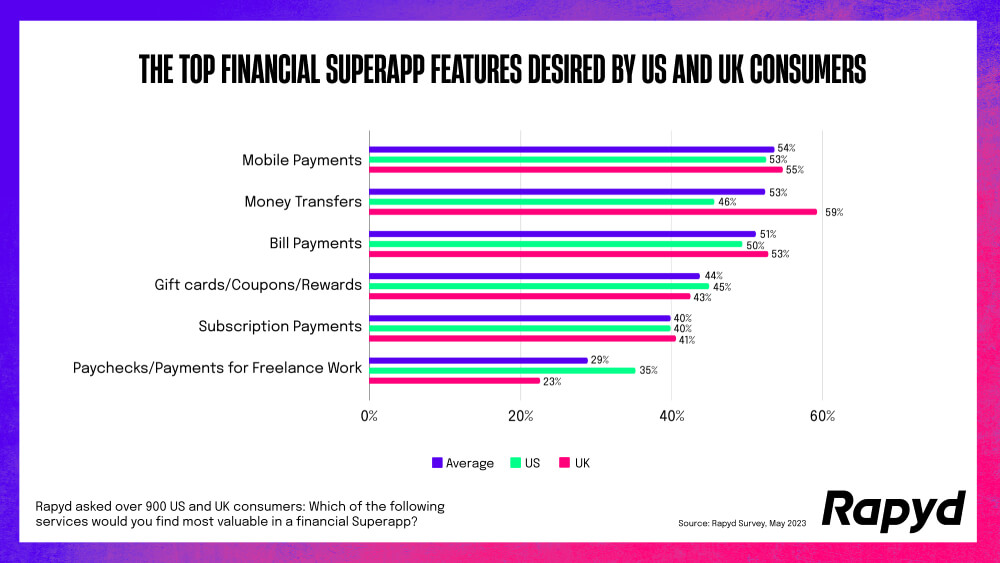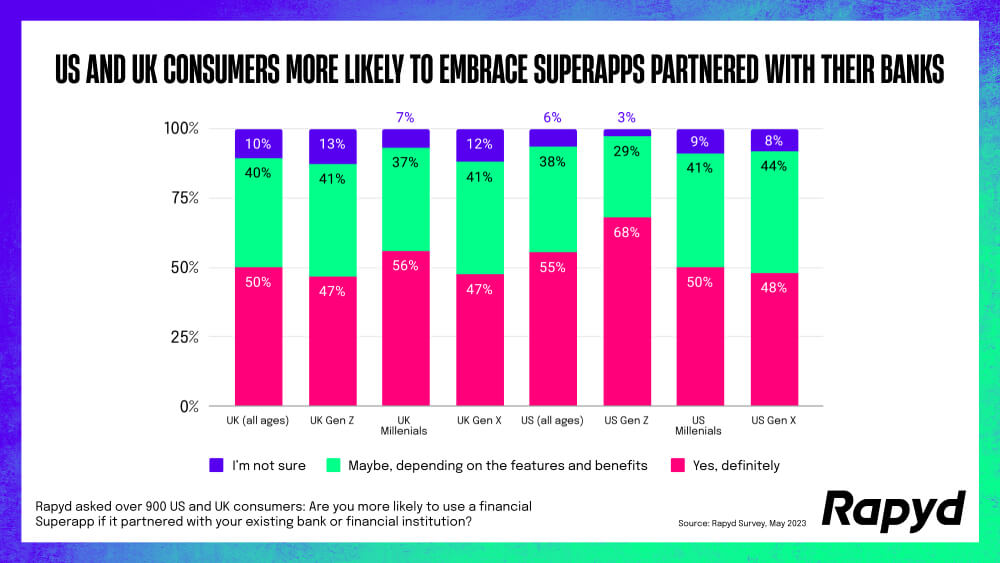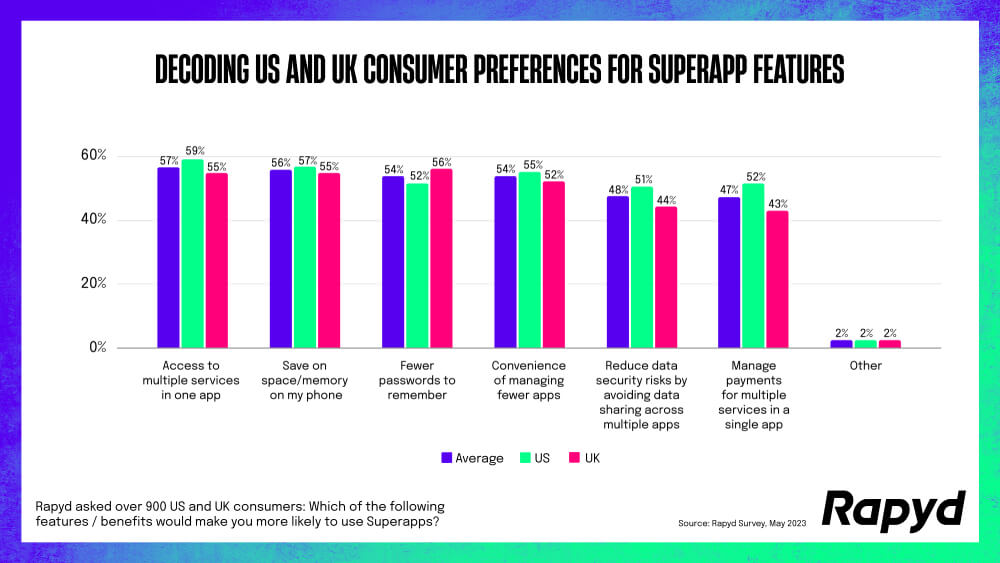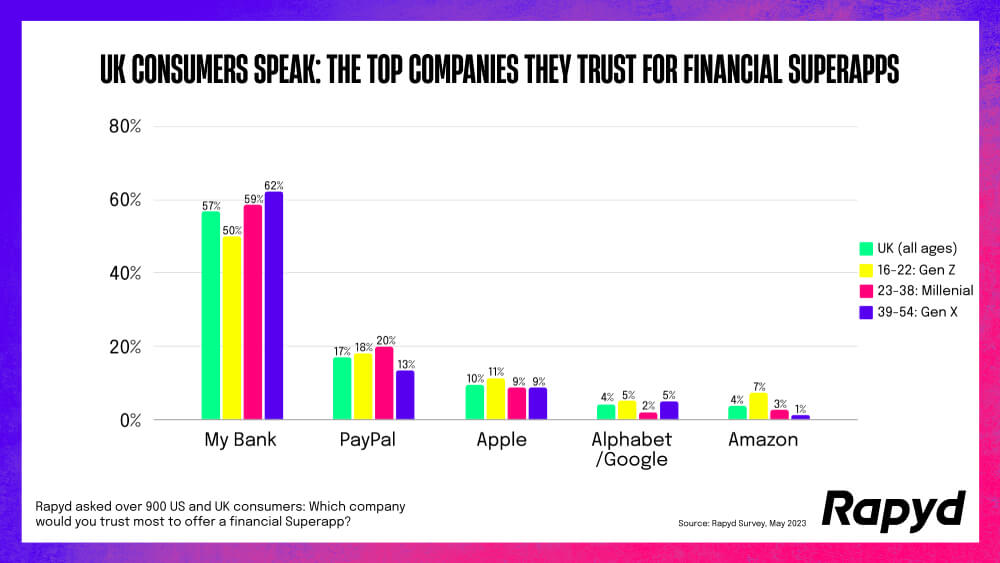Key Findings from Rapyd’s Survey on Superapps in the US and UK Sheds Light on How to Meet Consumer Expectations
A survey recently conducted by Rapyd offers a deep dive into U.S. and U.K. consumer sentiment towards superapps and reveals how businesses can align their superapp offerings with Western consumer needs and preferences.
Superapps are comprehensive platforms that integrate a multitude of services like food delivery, ride-hailing, shopping, and financial transactions in one place. The concept of superapps is fast becoming a focal point in tech and fintech discussions. Elon Musk has floated plans to turn Twitter into a superapp called X. And Mr. Musk isn’t the only one who thinks the West is primed for a superapp revolution. Deloitte is predicting that Superpps will emerge as a consumer trend in the US within the next two years. On the B2B side, the trend has already arrived. Platforms such as Shopify already function as superapps designed to serve small businesses.
The Global Superapp Landscape
Superapps have already changed the financial ecosystems of several regions, particularly in Latin America and Asia. Examples such as WeChat in China, Grab in Southeast Asia, and Rappi in Latin America clearly illustrate how superapps are already influencing digital consumer behavior. The trend is now gaining attention in the U.S. and the U.K. These apps can significantly impact digital consumer behavior and transform customer interactions with digital services.
Rapyd’s survey unpacks this emerging trend, providing key insights into the characteristics consumers want in a superapp and highlighting why the data is crucial for businesses aiming to capture this burgeoning market.
Key Findings From Rapyd’s Superapp Survey Include
- 57% of consumers are drawn towards superapps for the convenience of having multiple services in one application. Consumer desire more streamlined and unified digital experience.
- 56% of respondents cite preserving space on their mobile devices as a major motivation. With device storage at a premium, superapps can provide a space-efficient solution, housing multiple functionalities in one app rather than several.
- Millennials (ages 22-38) find the convenience of a unified platform and the space-saving aspects particularly appealing. Millennials (ages 22-38) are at the forefront of embracing the superapp revolution. Superapps cater to millennials’ desire for simplicity, time optimization, and personalized experiences. This demographic understands that a unified platform offers more than just space-saving benefits—it unlocks a new realm of possibilities where their diverse needs can be met effortlessly, empowering them to navigate their digital lives with ease and efficiency.
- Fintech services are central to superapps, with consumers showing a strong interest in integrating frequently used financial services like mobile purchases (54%), money transfers (53%), and bill payments (51%). This data reveals that robust fintech offerings are not only an added benefit but integral to the superapp experience.
- A significant number of respondents in both the U.S. and U.K. expressed a willingness to use a superapp if it is integrated with their bank or financial institution. In regions like Asia and LATAM, superapps have served as comprehensive financial platforms, even supplementing traditional banks in underbanked areas. However, in the mature financial markets of the US and UK, superapps are set to compete with established financial institutions. The willingness of respondents in both countries to adopt a superapp if integrated with their bank highlights the need for collaboration between fintech companies and traditional institutions – this collaboration is crucial as superapps strive to offer innovative financial services while leveraging the trust and reliability associated with established players.
Understanding Superapp Appeal
One of the main appeals of superapps is their capacity to simplify and streamline our digital lives. According to Rapyd’s findings, the top reasons behind superapp adoption include the convenience of having multiple services in one application (57%) and the desire to save space on mobile devices (56%). This data demonstrates a growing consumer trend towards a unified digital experience.
Millennials (ages 22-38) are the most drawn to the consolidation and space-saving attributes of superapps.
This is likely due to this demographic’s high digital literacy and preference for efficient solutions.

The Fintech Core of Superapps
Consumers indicated a strong interest in incorporating frequently used financial services into superapps, including mobile purchases (54%), money transfers (53%), and bill payments (51%). The demand for integrated financial services within superapps reveals the essential role that fintech plays in this ecosystem.
Trust: The Bedrock of Fintech and Superapps
Despite the interest in superapps, consumers also have concerns, primarily relating to data security and privacy. Over half of the survey’s respondents expressed worries about protecting their personal information, underscoring the importance of robust data protection mechanisms within superapps.
Trust, already vital in financial transactions, becomes even more crucial in the superapp context. U.K. consumers overwhelmingly trust their banks (57%) to offer a financial superapp, whereas in the U.S., banks, Amazon, and Apple emerged as top choices.
The Superapp Path Ahead
The survey’s findings underscore that while superapps represent a future direction for digital services, trust, security, and privacy – all cornerstones of fintech – remain central to their successful adoption. Fintech is not just part of the superapp conversation; it’s the core. As the digital world continues to progress, fintech will be at the forefront, powering superapps and transforming our digital experiences.








